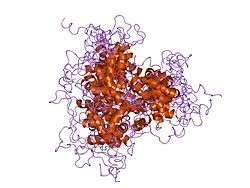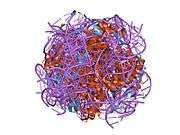FOXD3
Forkhead box D3 also known as FOXD3 is a forkhead protein that in humans is encoded by the FOXD3 gene.[5]
Function
This gene belongs to the forkhead protein family of transcription factors which is characterized by a DNA-binding forkhead domain. FoxD3 functions as a transcriptional repressor and contains the C-terminal engrailed homology-1 motif (eh1), which provides an interactive surface with a transcriptional co-repressor Grg4 (Groucho-related gene-4).[6]
Stem cells
Multiple studies have suggested Foxd3 involvement in the transition from naive to primed pluripotent stem cells in embryo development. Previously, Foxd3 was demonstrated to be required in maintaining pluripotency in mouse embryonic stem cells.[7] A recent finding further showed that Foxd3 is necessary as a repressor in the transition from ESC to epiblast-like cells (EpiLC).[8] The study proposed that Foxd3 is associated with inactivation of important naive pluripotency genes by its modification of chromatin structures via recruiting histone demethylases and decreasing the number of activating factors. Another proposed mechanism on the other hand argued that Foxd3 begins nucleosome removal and induction to a "primed" pluripotent state by recruiting Brg1, a nucleosome remodeler, and then acts as a repressor of maximal activation of those enhancers by recruiting histone deacetylases, suggesting a complex mediating function in which enhancers are primed for some future controlled time-point rather than immediate expression.[9] While there is no ambiguity that Foxd3 plays an important role regulating the transition from naive to primed pluripotency state, the two models show a different process. Attempts to reconcile the conclusions of the two studies have further suggested that Foxd3 functions as all of the above.[10]
Clinical significance
References
- 1 2 3 GRCh38: Ensembl release 89: ENSG00000187140 - Ensembl, May 2017
- 1 2 3 GRCm38: Ensembl release 89: ENSMUSG00000067261 - Ensembl, May 2017
- ↑ "Human PubMed Reference:".
- ↑ "Mouse PubMed Reference:".
- ↑ Hromas R, Moore J, Johnston T, Socha C, Klemsz M (June 1993). "Drosophila forkhead homologues are expressed in a lineage-restricted manner in human hematopoietic cells". Blood. 81 (11): 2854–9. PMID 8499623.
- ↑ Yaklichkin S, Steiner AB, Lu Q, Kessler DS (2007). "FoxD3 and Grg4 physically interact to repress transcription and induce mesoderm in Xenopus". J Biol Chem. 282 (4): 2548–5. doi:10.1074/jbc.M607412200. PMC 1780074. PMID 17138566.
- ↑ Hanna LA, Foreman RK, Tarasenko IA, Kessler DS, Labosky PA (2002). "Requirement for Foxd3 in maintaining pluripotent cells of the early mouse embryo". Genes Dev. 16 (20): 2650–61. doi:10.1101/gad.1020502. PMC 187464. PMID 12381664.
- ↑ Respuela P, Nikolić M, Tan M, Frommolt P, Zhao Y, Wysocka J, Rada-Iglesias A (2016). "Foxd3 Promotes Exit from Naive Pluripotency through Enhancer Decommissioning and Inhibits Germline Specification". Cell Stem Cell. 18 (1): 118–33. doi:10.1016/j.stem.2015.09.010. PMC 5048917. PMID 26748758.
- ↑ Krishnakumar R, Chen AF, Pantovich MG, Danial M, Parchem RJ, Labosky PA, Blelloch R (2016). "FOXD3 Regulates Pluripotent Stem Cell Potential by Simultaneously Initiating and Repressing Enhancer Activity". Cell Stem Cell. 18 (1): 104–17. doi:10.1016/j.stem.2015.10.003. PMC 4775235. PMID 26748757.
- ↑ Plank-Bazinet JL, Mundell NA (2016). "The paradox of Foxd3: how does it function in pluripotency and differentiation of embryonic stem cells?". Stem Cell Investig. 3: 73. doi:10.21037/sci.2016.09.20. PMC 5104585. PMID 27868055.
- ↑ Alkhateeb A, Fain PR, Spritz RA (August 2005). "Candidate functional promoter variant in the FOXD3 melanoblast developmental regulator gene in autosomal dominant vitiligo". J. Invest. Dermatol. 125 (2): 388–91. doi:10.1111/j.0022-202X.2005.23822.x. PMID 16098053.
Further reading
- Guo Y, Costa R, Ramsey H, et al. (2002). "The embryonic stem cell transcription factors Oct-4 and FoxD3 interact to regulate endodermal-specific promoter expression". Proc. Natl. Acad. Sci. U.S.A. 99 (6): 3663–7. doi:10.1073/pnas.062041099. PMC 122580. PMID 11891324.
- Levy D, Larson MG, Benjamin EJ, et al. (2007). "Framingham Heart Study 100K Project: genome-wide associations for blood pressure and arterial stiffness". BMC Med. Genet. 8 Suppl 1: S3. doi:10.1186/1471-2350-8-S1-S3. PMC 1995621. PMID 17903302.
- Saleem RA, Banerjee-Basu S, Berry FB, et al. (2001). "Analyses of the effects that disease-causing missense mutations have on the structure and function of the winged-helix protein FOXC1". American Journal of Human Genetics. 68 (3): 627–41. doi:10.1086/318792. PMC 1274476. PMID 11179011.
- Gregory SG, Barlow KF, McLay KE, et al. (2006). "The DNA sequence and biological annotation of human chromosome 1". Nature. 441 (7091): 315–21. doi:10.1038/nature04727. PMID 16710414.
- Buescher JL, Martinez LB, Sato S, et al. (2009). "YY1 and FoxD3 regulate antiretroviral zinc finger protein OTK18 promoter activation induced by HIV-1 infection". J Neuroimmune Pharmacol. 4 (1): 103–15. doi:10.1007/s11481-008-9139-x. PMC 2680142. PMID 19034670.





